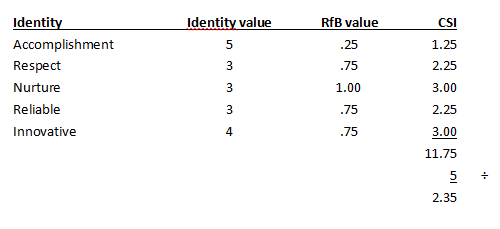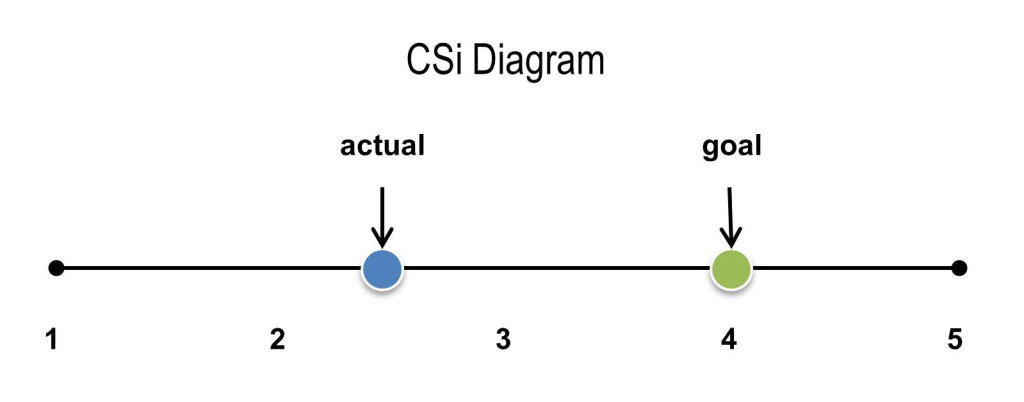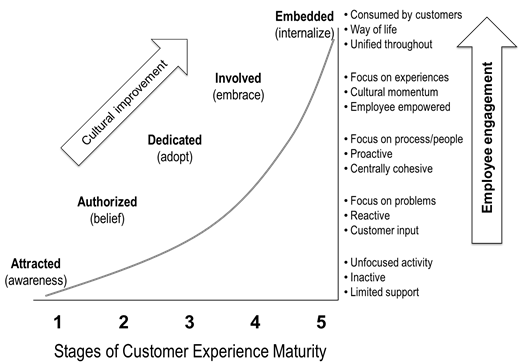Customer Experience is a blanket of interwoven threads of a company’s culture. If you want to generate great experience for your customers, weave a great blanket first.
By Robert Yurkovic
April 1, 2014
The organization must be of the right mind and follow disciplines to be effective. Culture can be used to explain the organization’s right mind. The organization must be treated as an organism in which care and feeding is paramount. An organization comprised of silos will have difficulty in working together with other organizations.
The consumer expects the company to interact with them in one voice and not as a person with multiple personalities that are always in conflict. The organization embraces its culture and radiates a brand image to attract, retain and manage its customer base.
Where culture comes from
Culture is an organic living thing that, in essence, defines who we are and how we behave. It shapes our routines, habits, and rituals. It can shape our environment and our environment can shape the culture. Deep inside of an organization or a group of people is a set of values or beliefs that governs us. The organization’s culture radiates who the collective body is and what it is capable of. The culture changes as people’s behaviors change and changes can be quick or slow to happen over time. As the organization’s environment shifts, its people adapt to it and their behaviors change which in turn alters the culture. Culture is dynamic and fragile and requires constant nurturing to maintain a steady state of its identity.
A company’s culture communicates its identity in everything it does especially in its customer’s touch points. This does not mean the company’s vision, brand, or mission statement defines the culture but it does impact and permeate all of these. A common disconnect is a vision that sets the tone for customer importance but the culture radiates an internally driven mindset of performance metrics and shareholder values instead of a consumer focused view. A disconnected culture communicates distrust and chaos to those around it as is becomes lost in an identity crisis.
A company’s identity is made up from a core set of values or beliefs. In an organization, the measurement of identity is how the organization defines its values as to who it is with respect to the world. Are they values that align to the consumer’s needs and values? To create a stronger impact to the culture, the organization must choose its values carefully much as it would in determining its brand image. The same goes for individuals who have adopted a set of beliefs that show who they are; it defines them to others. Politicians start their campaigns with a core set of values on which their platform is run. This defines them as it relates to the people. Identity says who we are but that is not enough to truly define us or show our strength.
So the next element is defining the “reason for being” or Raison d’etre. The reason for being (RfB) drives the identity into action since it touches on our belief system and how we make decisions. In an organization, the measurement of its reason for being is how the organization embraces its purposeful existence and identity. An example of measurement could be how its consumer’s health index changed or how many targeted health programs were launched. I have asked many executives a simple question, “what does the company want to be when it grows up?” The question is meant to stimulate a response stating its reason for being. Yet, some executives get flustered by the question. Most executives can communicate their company’s identity, but their reason for being has not been fully shaped. It is a difficult question to answer and requires thoughtful effort. It is similar to, “Now that you know who you are, what are you going to do about it?”
Employees have a difficult time embracing a new identity without knowing its reason for being. This gets into the questions of why we are here. With this, employees experience a sense of bewilderment and think, “Now what do I do with that?” as the new identity (set of values and beliefs) rolls out. If the old identity has been modified with new values and communicated, the culture’s foundation becomes unsettled and cultural implosion occurs leaving everyone trying to figure out what to do next. Even the identity comes into question. If executives modify the culture with a new identity and reason for being but do not “walk the talk” and lead by example, cultural implosion occurs as employees lose faith in their leaders. The new message becomes diluted. This is what I mean by a culture being fragile. It can be easily fractured if you do not manage the transformation carefully. It is not about changing processes and procedures; it is about modifying an organic, living thing in real time.
Cultural Strength index
The “reason for being” defines purposeful existence and along with identity provides a way to measure strength and impact of the culture. Identity and purpose (RfB) craft the elemental pieces of a culture’s core. Cultural strength is about where it is going and what force moves it. This is basically a cultural vector and can be used to measure strength and impact. In physics, a vector is defined as two components – direction and force.
In a cultural vector, the direction is related to identity and the force is related to the reason for being (RfB). The RfB gives the identity a push to its direction. From this point of view, we can calculate a Cultural Strength index (CSi).

The value n represents the total number of identity values. For the purpose of using this in healthcare, let’s measure cultural strength for consumer centricity. The indicators should align to the consumer.
Identity examples:
- Charitable – giving to others and helpful
- Accomplishment – achieve internal business success, achieve increases member health
- Accountable – accept responsibility
- Thoughtful – caring and considerate
- Respectful – value the person and their values
- Empowerment – letting people do what they need to do
- Nurture – helping people grow and become strong
- Reliable – honest, dependable, and do the right thing
- Innovative – taking risks, pioneering, bold steps
For measurement purposes, Identity has a value of 1 to 5 with 5 closely aligned to how well it has been embraced internally and recognized externally.
1 = refusal to support
2 = passive aggressive resistance
3 = recognized by management, the message is apparent but results are limited
4 = partially supported by management, spotty results and adoption
5 = embraced by management, embedded in enterprise, apparent
There can be conflicts in the values such as being charitable and accomplished internally. Performance commitments to shareholders can impact on ability to be charitable. There can also be a gap between cultural norms and ideal values as the organization focuses on moving to an ideal state.
The reason for being is coupled to an identity value and in this case is given a value based on consumer alignment. Some of the example below can be tied to more than one identity value. Reason for being examples:
- Company financials – margin expectations tied to accomplishment
- Member cost control – reducing medical costs for members tied to accomplishment
- Company growth – number of members tied to accomplishment
- Caring for members – making decisions for member health tied to thoughtful and nurture
- Care quality – the best care for the member
- Enablement – enabling members with tools and information to make better decisions tied to innovative
- Engagement – engaging members in better health with programs and information
- Relationships – connecting with members in a personalized manner
- Logistics – focus on health logistics (locate care, travel, payment) so the member can focus on their health
- Medical cost control – reducing medical costs to meet financials
- Health threats – working with data and research to minimize future health threats to members tied to innovative
For measurement purposes, RfB has a value between 0 and 1. This value shows how well it is aligned to a consumer.
0.00 = 0% consumer aligned
0.25 = 25% consumer aligned
0.50 = 50% consumer aligned
0.75 = 75% consumer aligned
1.00 = 100% consumer aligned
CSi Example for Consumer Centricity
For example, let’s take a fictitious healthcare company and create an identity and reason for being for those values.
The values are: Accomplishment for shareholder value, respect for members and employees, reliable, and innovative. Across the business, we see limited acceptance and adoption for these values and this is shown in the following score card:
Place the final score on the CSi diagram. With 5 being the maximum score, a score of close to 2 shows the company’s strength to support consumer oriented programs. A goal of 4 is chosen to represent where they want to be. The goal is to partially embrace its 5 identity values. The question arises, “Are they focused on the right things and are their priorities correct to be consumer driven?”
In this example, the company is strongly focused on achieving growth and financial targets for internal purposes and for its shareholders. Accomplishment received an identity value of 5 due to its strong support but received an RfB value of .25 since the value is more closely aligned to internal business needs as opposed to consumer needs. The company chose a strong identity value of nurture with an RfB value of 1 but its identity value is 3 since it has not been embraced fully in the company so its effectiveness is diminished. For the company to succeed in a consumer environment, it must look at values that align to that objective and embrace them for full effectiveness. Only then can it deploy great customer experiences.
Creating a strong set of cultural values by itself does not translate to a strong culture. Having a strong set of values can produce a weak cultural impact by the organization’s reluctance to embrace its desired identity and its reason for being.
Steps to Cultural Rejuvenation
In order to generate a better customer experience for its customers, the company’s culture must be customer centric first. There are several steps to cultural rejuvenation and I call it rejuvenation because a culture is always already in existence. In order to generate a new culture, you must first deal with the old culture and its identity. If you do not acknowledge the embedded culture, contamination to any cultural changes will occur with deleterious effects. The original or embedded culture must be dealt with before proceeding. People need to acknowledge what was there and let it go willingly. It is human behavior to hold on to something even though it can be bad for them and others.
There are five basic steps to cultural rejuvenation:
- Look at who you are deeply – Current State Analysis
- Identify the old culture
- Identify the root causes for what is not working
- Create your identity and Raison d’etre – Future State
- What are the values that define the organization? Impactful. Simple. Real. Soulful.
- What is the organization’s reason for being? What do you want to be when you grow up? Where are you going with your new identity (values)?
- Generate awareness of where you are and the right path to follow – Gap Analysis
- Communicate what you learned about the old identity and what is does or has done
- Show the organization the problem areas to correct behaviors
- Provide tools to correct root causes
- Show a path to the new direction, new identity and reason for being
- Build a roadmap and make it actionable
- Provide tools that correct behaviors and stimulate people to embrace a better way
- Validate that executives are buying in
- Create metrics to measure your actions
- Communicate internally and externally
- Maintain and monitor your progress
- Provide oversight
- Provide a feedback mechanism to all
- Reinforce in a positive manner
- Own and correct mistakes in real time
- Validate direction and policies are inline
- Review threats and risks
Experience and Culture
Today, many businesses desire to have better experiences for their customers. They want to be customer centric especially as the world shifts to a B2C model as seen in many industries. Healthcare companies are moving to generate better customer experiences to increase retention and improve member engagement.
The diagram below is a Customer Experience Maturity Model with 5 stages. Many healthcare companies are in stage two and ready to start stage 3 as customer experience management obtains funding and acknowledgement by executives.
At stage 4, companies have embraced the B2C model and are ready to generate engaging experiences for their customers. At this point, the culture is more aligned to consumer values and with that, customer experiences can be generated to build out engagement programs and manage all consumer/member interactions across the business. In this stage, customers see coordinated and consistent interactions and a positive brand image begins to form.
If you are still in early stages of cultural rejuvenation, you can still generate better customer experiences by fixing problem areas and optimizing processes and coordinating organizational connections. Both cultural rejuvenation and customer experience generation can be grown in a multi-stage maturity model as shown above. Customers will see value as you shift your business to a consumer driven model over time.
Summary
An organization’s culture has the amazing capability to leak its identity and Raison d’etre to consumers. Experiences, good or bad, are remembered and shared instantly in the mobile world through social channels. This can be harmful if your company has unresolved issues or disconnects embedded in its culture. Bad news can go viral as well so care must be taken in managing social channels. Social channels can be used to amplify cultural values with consumers taking the role of marketing your messages to others.
Customer experiences create the framework for member engagement. Culture creates the framework for customer experiences. When considering how to create great experiences for your customers, think about weaving the experiential blanket using strands of culture at the onset.


